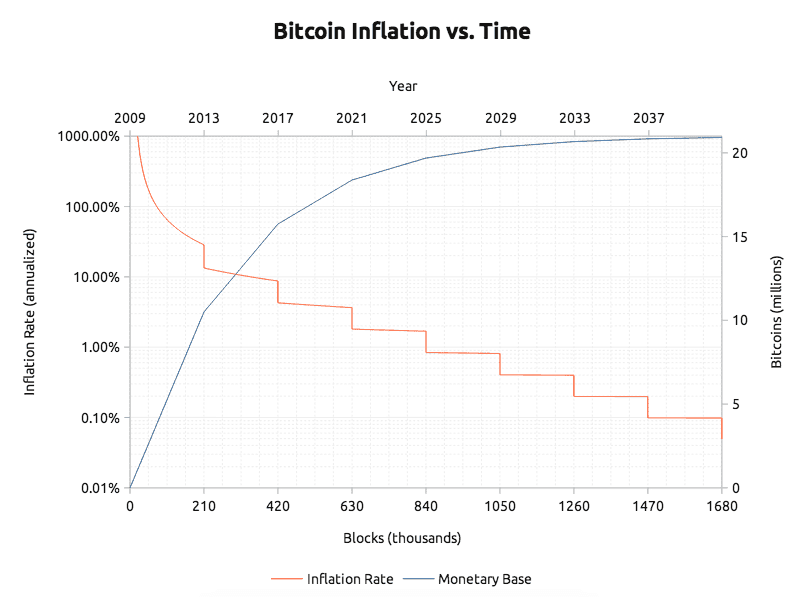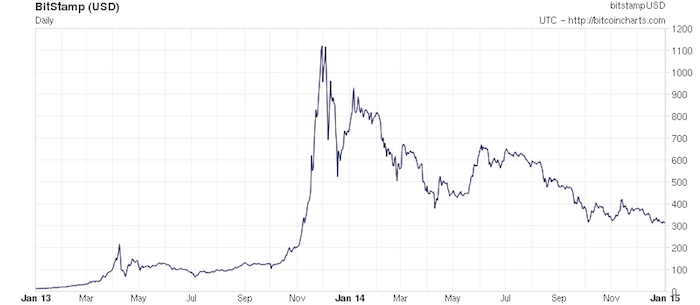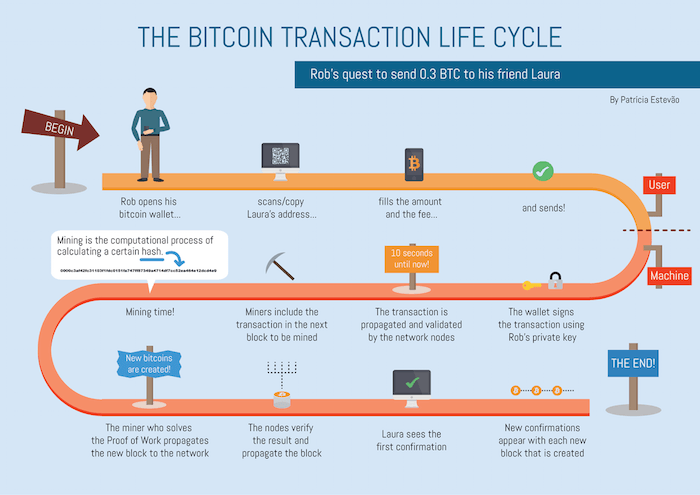How are bitcoins created?
New bitcoins are generated by a competitive and decentralized process called "mining". This process involves individuals that are rewarded by the network for their services. Bitcoin miners are processing transactions and securing the network using specialized hardwareand are collecting new bitcoins in exchange.
The Bitcoin protocol is designed in such a way that new bitcoins are created at a fixed rate. This makes Bitcoin mining a very competitive business. When more miners join the network, it becomes increasingly difficult to make a profit and miners must seek efficiency to cut their operating costs. No central authority or developer has any power to control or manipulate the system to increase their profits. Every Bitcoin node in the world will reject anything that does not comply with the rules it expects the system to follow.
Bitcoins are created at a decreasing and predictable rate. The number of new bitcoins created each year is automatically halved over time until bitcoin issuance halts completely with a total of 21 million bitcoins in existence. At this point, Bitcoin miners will probably be supported exclusively by numerous small transaction fees.

Why do bitcoins have value?
Bitcoins have value because they are useful as a form of money. The Bitcoin price can be highly volatile. Bitcoin has the characteristics of money (durability, portability, fungibility, scarcity, divisibility, and recognizability) based on the properties of mathematics rather than relying on physical properties (like gold and silver) or trust in central authorities (like fiat currencies). In short, Bitcoin is backed by mathematics. With these attributes, all that is required for a form of money to hold value is trust and adoption. In the case of Bitcoin, this can be measured by its growing base of users, merchants, and startups. As with all currency, bitcoin's value comes only and directly from people willing to accept them as payment.
What determines bitcoin’s price?
The price of a bitcoin is determined by supply and demand. When demand for bitcoins increases, the price increases, and when demand falls, the price falls. There is only a limited number of bitcoins in circulation and new bitcoins are created at a predictable and decreasing rate, which means that demand must follow this level of inflation to keep the price stable. Because Bitcoin is still a relatively small market compared to what it could be, it doesn't take significant amounts of money to move the market price up or down, and thus the price of a bitcoin is still very volatile. Plus, many people do not really know how Bitcoin margin calls work.
Bitcoin price over time:

Can bitcoins become worthless?
Yes. History is littered with currencies that failed and are no longer used, such as the German Mark during the Weimar Republic and, more recently, theZimbabwean dollar. Although previous currency failures were typically due to hyperinflation of a kind that Bitcoin makes impossible, there is always potential for technical failures, competing currencies, political issues and so on. As a basic rule of thumb, no currency should be considered absolutely safe from failures or hard times. Bitcoin has proven reliable for years since its inception and there is a lot of potential for Bitcoin to continue to grow. However, no one is in a position to predict what the future will be for Bitcoin.
Is Bitcoin a bubble?
A fast rise in price does not constitute a bubble. An artificial over-valuation that will lead to a sudden downward correction constitutes a bubble. Choices based on individual human action by hundreds of thousands of market participants is the cause for bitcoin's price to fluctuate as the market seeks price discovery. Reasons for changes in sentiment may include a loss of confidence in Bitcoin, a large difference between value and price not based on the fundamentals of the Bitcoin economy, increased press coverage stimulating speculative demand, fear of uncertainty, and old-fashioned irrational exuberance and greed.
Is Bitcoin a Ponzi scheme?
A Ponzi scheme is a fraudulent investment operation that pays returns to its investors from their own money, or the money paid by subsequent investors, instead of from profit earned by the individuals running the business. Ponzi schemes are designed to collapse at the expense of the last investors when there is not enough new participants.
Bitcoin is a free software project with no central authority. Consequently, no one is in a position to make fraudulent representations about investment returns. Like other major currencies such as gold, United States dollar, euro, yen, etc. there is no guaranteed purchasing power and the exchange rate floats freely. This leads to volatility where owners of bitcoins can unpredictably make or lose money. Beyond speculation, Bitcoin is also a payment system with useful and competitive attributes that are being used by thousands of users and businesses.
Doesn't Bitcoin unfairly benefit early adopters?
Some early adopters have large numbers of bitcoins because they took risks and invested time and resources in an unproven technology that was hardly used by anyone and that was much harder to secure properly. Many early adopters spent large numbers of bitcoins quite a few times before they became valuable or bought only small amounts and didn't make huge gains. There is no guarantee that the price of a bitcoin will increase or drop. This is very similar to investing in an early startup that can either gain value through its usefulness and popularity, or just never break through. Bitcoin is still in its infancy, and it has been designed with a very long-term view; it is hard to imagine how it could be less biased towards early adopters, and today's users may or may not be the early adopters of tomorrow.
Won't the finite amount of bitcoins be a limitation?
Bitcoin is unique in that only 21 million bitcoins will ever be created. However, this will never be a limitation because transactions can be denominated in smaller sub-units of a bitcoin, such as bits - there are 1,000,000 bits in 1 bitcoin. Bitcoins can be divided up to 8 decimal places (0.000 000 01) and potentially even smaller units if that is ever required in the future as the average transaction size decreases.
Won't Bitcoin fall in a deflationary spiral?
The deflationary spiral theory says that if prices are expected to fall, people will move purchases into the future in order to benefit from the lower prices. That fall in demand will in turn cause merchants to lower their prices to try and stimulate demand, making the problem worse and leading to an economic depression.
Although this theory is a popular way to justify inflation amongst central bankers, it does not appear to always hold true and is considered controversial amongst economists. Consumer electronics is one example of a market where prices constantly fall but which is not in depression. Similarly, the value of bitcoins has risen over time and yet the size of the Bitcoin economy has also grown dramatically along with it. Because both the value of the currency and the size of its economy started at zero in 2009, Bitcoin is a counterexample to the theory showing that it must sometimes be wrong.
Notwithstanding this, Bitcoin is not designed to be a deflationary currency. It is more accurate to say Bitcoin is intended to inflate in its early years, and become stable in its later years. The only time the quantity of bitcoins in circulation will drop is if people carelessly lose their wallets by failing to make backups. With a stable monetary base and a stable economy, the value of the currency should remain the same.
Isn't speculation and volatility a problem for Bitcoin?
This is a chicken and egg situation. For bitcoin's price to stabilize, a large scale economy needs to develop with more businesses and users. For a large scale economy to develop, businesses and users will seek for price stability.
Fortunately, volatility does not affect the main benefits of Bitcoin as a payment system to transfer money from point A to point B. It is possible for businesses to convert bitcoin payments to their local currency instantly, allowing them to profit from the advantages of Bitcoin without being subjected to price fluctuations. Since Bitcoin offers many useful and unique features and properties, many users choose to use Bitcoin. With such solutions and incentives, it is possible that Bitcoin will mature and develop to a degree where price volatility will become limited.
In fact, in April 2016 Bitcoin's volatility reached record levels, close to that of gold, and other fiat pairs.
What if someone bought up all the existing bitcoins?
Only a fraction of bitcoins issued to date are found on the exchange markets for sale. Bitcoin markets are competitive, meaning the price of a bitcoin will rise or fall depending on supply and demand. Additionally, new bitcoins will continue to be issued for decades to come. Therefore even the most determined buyer could not buy all the bitcoins in existence. This situation isn't to suggest, however, that the markets aren't vulnerable to price manipulation; it still doesn't take significant amounts of money to move the market price up or down, and thus Bitcoin remains a volatile asset thus far.
What if someone creates a better digital currency?
That can happen. For now, Bitcoin remains by far the most popular decentralized virtual currency, but there can be no guarantee that it will retain that position. There is already a set of alternative currencies inspired by Bitcoin. It is however probably correct to assume that significant improvements would be required for a new currency to overtake Bitcoin in terms of established market, even though this remains unpredictable. Bitcoin could also conceivably adopt improvements of a competing currency so long as it doesn't change fundamental parts of the protocol.
Since Bitcoin was the first digital currency and is the most widely used today, it has a strong advantage over its competitors due to network effects:
Transactions
 Visualize and Download High-Resolution Infographic
Visualize and Download High-Resolution InfographicWhy do I have to wait 10 minutes?
Receiving a payment is almost instant with Bitcoin. However, there is a 10 minutes delay on average before the network begins to confirm your transaction by including it in a block and before you can spend the bitcoins you receive. A confirmation means that there is a consensus on the network that the bitcoins you received haven't been sent to anyone else and are considered your property. Once your transaction has been included in one block, it will continue to be buried under every block after it, which will exponentially consolidate this consensus and decrease the risk of a reversed transaction. Every user is free to determine at what point they consider a transaction confirmed, but 6 confirmations is often considered to be as safe as waiting 6 months on a credit card transaction.
How much will the transaction fee be?
Most transactions can be processed without fees, but users are encouraged to pay a small voluntary fee for faster confirmation of their transactions and to remunerate miners. When fees are required, they generally don't exceed a few pennies in value. Your Bitcoin client will usually try to estimate an appropriate fee when required, or you can use a fee predictor.

Transaction fees are used as a protection against users sending transactions to overload the network. The precise manner in which fees work is still being developed and will change over time. Because the fee is not related to the amount of bitcoins being sent, it may seem extremely low (0.0005 BTC for a 1,000 BTC transfer) or unfairly high (0.004 BTC for a 0.02 BTC payment). The fee is defined by attributes such as data in transaction and transaction recurrence. For example, if you are receiving a large number of tiny amounts, then fees for sending will be higher. Such payments are comparable to paying a restaurant bill using only pennies. Spending small fractions of your bitcoins rapidly may also require a fee. If your activity follows the pattern of conventional transactions, the fees should remain very low.
What if I receive a bitcoin when my computer is powered off?
This works fine. The bitcoins will appear next time you start your wallet application. Bitcoins are not actually received by the software on your computer, they are appended to a public ledger that is shared between all the devices on the network. If you are sent bitcoins when your wallet client program is not running and you later launch it, it will download blocks and catch up with any transactions it did not already know about, and the bitcoins will eventually appear as if they were just received in real time. Your wallet is only needed when you wish to spend bitcoins.
What does "synchronizing" mean and why does it take so long?
Long synchronization time is only required with full node clients like Bitcoin Core. Technically speaking, synchronizing is the process of downloading and verifying all previous Bitcoin transactions on the network. For some Bitcoin clients to calculate the spendable balance of your Bitcoin wallet and make new transactions, it needs to be aware of all previous transactions. This step can be resource intensive and requires sufficient bandwidth and storage to accommodate the full size of the block chain. For Bitcoin to remain secure, enough people should keep using full node clients because they perform the task of validating and relaying transactions.
What does increasing the block size limit mean?
The blocksize limit is what ensures everyone can participate in the Bitcoin network, and it ensures everyone can participate anonymously should they choose too. Some people want to remove this protection to make Bitcoin scale, but we can have the best of both worlds: high transaction volume and true decentralization with off-chain transactions. Solutions like Segregated Witnessand Lightning Network are creative scaling solutions and don't require changes to the blocksize limit.



